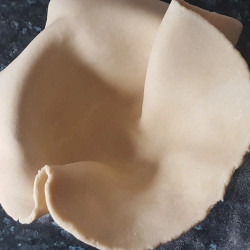Start with the filling. Melt the butter in a saucepan and add the leek or onion and potatoes, season with half a teaspoon of salt and a good grind of pepper. Cook over a medium heat until the leek or onion melts right down. Do this slowly, turning down the heat if necessary – you don’t want to fry them, though a pale golden brown colour is fine.
Stir in the flour and mustard and cook for a minute before mixing half of the milk. When the milk combines with the flour to make a smooth sauce, add the remainder of the milk and combine again.
Simmer gently for 10 minutes, stirring occasionally. Then remove from the heat and stir in the cheese. Mix in the Cayenne pepper. Check the seasoning and add more salt and pepper. It’s a good idea to slightly over season the filling to make up for the comparatively bland shortcrust pastry. Finally stir in the cream and allow to cool completely. I usually make my cooked fillings a day or two ahead of time.
Now make the pastry. Rub the fat(s) into the flour. If you are using unsalted butter, add half a teaspoon of salt. If you are making pastry by hand, unless you have forearms like Popeye, use fats that are at room temperature. If using a mixer, use the flat beater and use cold fats straight from the fridge. Either way, once it resembles breadcrumbs add the water a couple of tablespoons at a time until you have a soft but not sticky dough. Knead very briefly, wrap in cling film and leave it rest in the fridge for 30 minutes.
After resting, take around a third of the dough and roll out on a lightly floured worktop. I used an 18 cm cake tin because I like deep-filled pies, but a shallow pie dish or flan ring of around 25 cm would work too. Roll out a third of the pastry into a circle. Leave the pastry to rest again for a minute or so before laying it in the tin. Be careful to press the pastry into the corners without stretching it: lift it in carefully. If using a deep dish as I have it’s helpful to fold the pastry into quarters, placing it in the dish or tin and then unfolding it.
Roll out the remainder of the pastry to make a lid. Cut a steam hole in the centre and set aside.
Spoon in the pie filling, but don’t fill it too much – it does expand as it cooks. Now brush the edges with egg wash (I use an egg, or egg yolk, beaten with half a teaspoon of salt). Glue the lid in place, pressing the lid down well.
Trim the excess pastry with a sharp knife and then crimp the edges or use a fork to seal the lid. Paint with more egg wash, and if you like add a bit more black pepper. Place in the fridge to set the pastry.
Preheat your oven to 220°C and pop a baking tray on the centre shelf.
(If you have any left-over pastry and filling, make a pasty with it (see here for my Cornish pasty recipe) and bake it with the pie, or freeze it. Both pastry and filling freeze well separately.)
Take the pie out of the fridge and place in the oven on the hot baking tray (this prevents a soggy bottom from developing) and bake for 45 minutes, turning down the heat to 180°C when the pastry is a nice golden brown.
